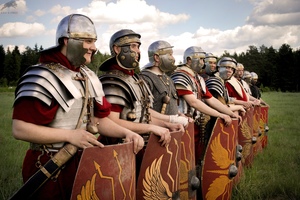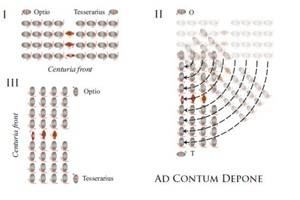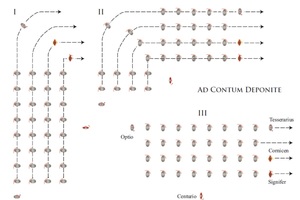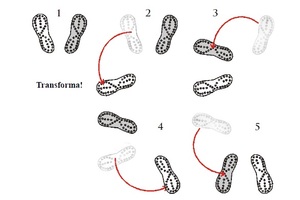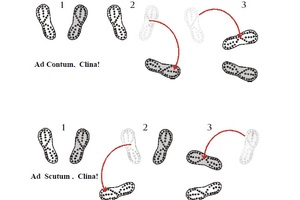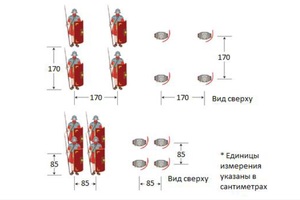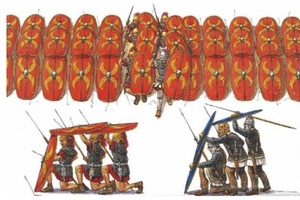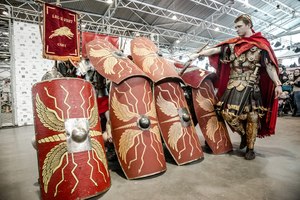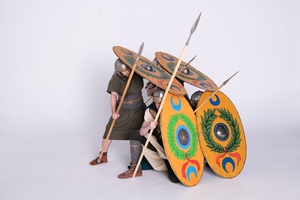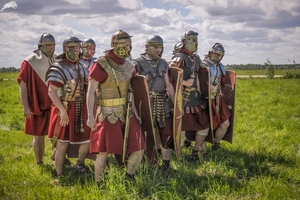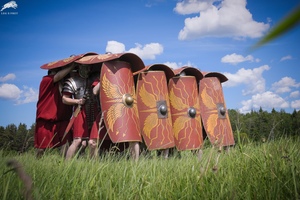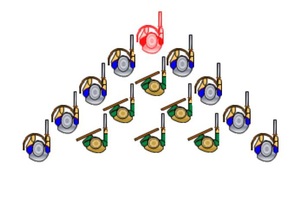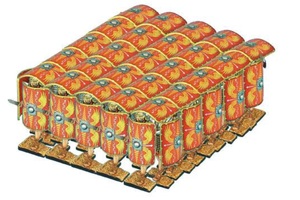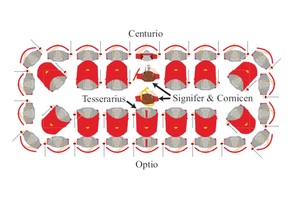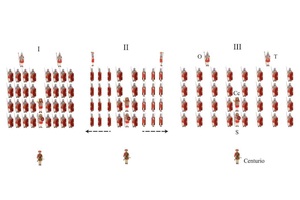Roman Drill Commands
The Roman army, renowned for its discipline and clear commands since the Republican era, effectively utilized these attributes to implement battle strategies and formations that were unconventional for their time.
This article introduces the reader to the Latin commands and their execution in Ancient Rome, as well as demonstrating how modern reenactors use these drill commands. The sources for these commands are listed at the end of the article. The primary source is the most comprehensive treatise on later Roman military strategy: "Strategikon of Maurice," supplemented by earlier written sources from authors such as Vegetius and Polybius.
Part 1. The basics
General Commands:
Dirige frontem – [dí-rige frón-tem] – attention
Venite – [ve-ní-te] – form up
Reverte – [re-vér-te] – cancel command
Signum demittite – [síg-num de-mít-ti-te] – dismiss
Silentium – [si-lén-ti-um] – silence
Mandata captate – [man-dá-ta kap-tá-te] – attention
Turns:
Ad contum, clina – [ad kón-tum klí-na] – right turn
Ad scutum, clina – [ad skú-tum klí-na] – left turn
Move ad contum – [mó-ve ad kón-tum] – step to the right
Move ad scutum – [mó-ve ad skú-tum] – step to the left
Ad contum (scutum) depone – [ad kón-tum (skú-tum) de-pó-ne] – right (left) shoulder turn
Ad contum (scutum) deponite – [ad kón-tum (skú-tum) de-pó-ni-te] – right (left) turn while moving, leader turns first, others follow
Battle Commands::
Arma portate – [ár-ma por-tá-te] – take up arms
Arma demittite – [ár-ma de-mít-ti-te] – lower arms
Ad arma – [ad ár-ma] – to arms
Gladius destrigite – [glá-di-us des-trí-gi-te] – draw swords
Gladius recondite – [glá-di-us re-kón-di-te] – sheathe swords
Vos servate – [vós ser-vá-te] – shield yourselves
Percute – [per-kú-te] – advance, close in on the enemy with shields up
Pila tollite – [pí-la tól-li-te] – prepare pilum for throwing
Pila jactate – [pí-la yak-tá-te] – throw pilum
Movement:
Transforma – [trans-fó-r-ma] – about face
Redi! – [ré-di] – return to position
Movete – [mo-vé-te] – forward march
Ad contum (scutum) move – [ad kón-tum (skú-tum) mó-ve] – step to the right (left)
State – [stá-te] – halt
Celerate – [kèl-e-rá-te] – faster
Tardate – [tar-dá-te] – slower
Cede – [ké-de] – move back (until the command "Sta")
Sta – [sta] – halt movement back
Unum, duo, tres, sta – [ú-num dú-o trés stá] – one, two, three, halt
Gradum servate – [grá-dum ser-vá-te] – keep pace
Part 2. Basic Formation
Alignment of the formation is based on the right member. Shield overlapping in a close formation also aligns to the right. After counting off into "first" and "second" (prímus, secúndus), the second numbers (secúndi) step back and right to form behind the first numbers (prími).
In primum, secundum numeramini – [in prí-mum se-kúnd-um nu-me-rá-mi-ni] – count off by first and second
Ad duo, intra! – [ad dú-o, ín-tra] – form two ranks from one rank
Ad duo, exi! – [ad dú-o, ék-si] – form two ranks from four ranks
Ad quattuor, intra! – [ad kwát-tu-or, ín-tra] – form four ranks from two ranks
Ad quattuor, exi! – [ad kwát-tu-or, ék-si] – form four ranks from eight ranks
Ad octo, intra! – [ad ók-to, ín-tra] – form eight ranks from four ranks
Ad unum, exi! – [ad ú-no, ék-si] – form one rank from two ranks
Iunge – [yún-ge] – close ranks to elbow distance
Largi – [lár-gi] – open ranks
Mutare – [mu-tá-re] – replace the first rank; on "mu-ta," the second rank covers the first rank with shields, on "re," the first rank moves to the last row through the right side, backing up without exposing themselves.
Part 3. Special Formations
Murus – [mú-rus] – form a wall of shields
On "mu," the first rank places shields in front, kneels down, and braces them. If equipped with pilum/spear, it is angled at 45 degrees and braced against the ground and foot. On "rus," the second rank places shields over the first, and the third over the second. Subsequent ranks do not overlap shields.
Tela – [té-la] – form a protective formation against projectiles
On "te," the first rank covers with shields; the second and following ranks lift and rotate shields 90 degrees. On "la," the second and subsequent ranks overlap shields over the legionnaire in front.
Ad cuneum – [ad kú-ne-um] – form a wedge
Formation occurs relative to the center (centurion/optio). The center stays in place; adjacent soldiers step back two steps. Each subsequent soldier steps back two steps more than the previous. The vexillation group moves inside the wedge, centered and far from the center.
Ad testudinem – [ad tes-tú-di-nem] – form a tortoise
On "ad tes," the first rank covers with shields; the second and following ranks lift and rotate shields 90 degrees, ready to overlap, except for flank legionnaires who cover their flank regardless of rank (right flank holds shields in the right hand). On "tu-di," the second and following ranks overlap shields over the legionnaire in front. On "nem," flank legionnaires tightly join the formation, covering the "tortoise" from the sides.
Undique servate – [un-dí-kwe ser-vá-te] – form a circular defense
On "un-di-kwe," legionnaires form a defensive perimeter. On "ser-va-te," the remaining legionnaires cover the top of the outer perimeter with shields. The standard-bearing group stands in the center.
In the presence of a vexillarius, alignment and shield overlapping are based on him (those to his right align left, those to his left align right, with shield overlapping accordingly). The same applies to formations with a change in the number of rows.
Glossary of Commands
Silentium – [si-lén-ti-um] – silence
Mandata captate – [man-dá-ta kap-tá-te] – attention
Dirige frontem – [dí-ri-ge frón-tem] – attention
Venite – [ve-ní-te] – form up
Signum demittite – [síg-num de-mít-ti-te] – dismiss
Reverte – [re-vér-te] – cancel command
Ad contum, clina – [ad kón-tum klí-na] – right turn
Ad scutum, clina – [ad skú-tum klí-na] – left turn
Move ad contum – [mó-ve ad kón-tum] – step to the right
Move ad scutum – [mó-ve ad skú-tum] – step to the left
Ad contum (scutum) depone – [ad kón-tum (skú-tum) de-pó-ne] – right (left) shoulder turn
Ad contum (scutum) deponite – [ad kón-tum (skú-tum) de-pó-ni-te] – right (left) turn while moving, leader turns first, others follow
Transforma – [trans-fó-r-ma] – about face
Redi! – [ré-di] – return to position
Arma portate – [ár-ma por-tá-te] – take up arms
Arma demittite – [ár-ma de-mít-ti-te] – lower arms
Ad arma – [ad ár-ma] – to arms
Gladius destrigite – [glá-di-us des-trí-gi-te] – draw swords
Gladius recondite – [glá-di-us re-kón-di-te] – sheathe swords
Vos servate – [vós ser-vá-te] – shield yourselves
Percute – [per-kú-te] – advance, close in on the enemy with shields up
Pila tollite – [pí-la tól-li-te] – prepare pilum for throwing
Pila jactate – [pí-la yak-tá-te] – throw pilum
Movete – [mo-vé-te] – forward march
Ad contum (scutum) move – [ad kón-tum (skú-tum) mó-ve] – step to the right (left)
State – [stá-te] – halt
Celerate – [kèl-e-rá-te] – faster
Tardate – [tar-dá-te] – slower
Cede – [ké-de] – move back (until the command "Sta")
Sta – [sta] – halt movement back
Unum, duo, tres, sta – [ú-num dú-o trés stá] – one, two, three, halt
Gradum servate – [grá-dum ser-vá-te] – keep pace
In primum, secundum numeramini – [in prí-mum se-kúnd-um nu-me-rá-mi-ni] – count off by first and second
Ad duo, intra! – [ad dú-o, ín-tra] – form two ranks from one rank
Ad duo, exi! – [ad dú-o, ék-si] – form two ranks from four ranks
Ad quattuor, intra! – [ad kwát-tu-or, ín-tra] – form four ranks from two ranks
Ad quattuor, exi! – [ad kwát-tu-or, ék-si] – form four ranks from eight ranks
Ad octo, intra! – [ad ók-to, ín-tra] – form eight ranks from four ranks
Ad unum, exi! – [ad ú-no, ék-si] – form one rank from two ranks
Iunge – [yún-ge] – close ranks to elbow distance
Largi – [lár-gi] – open ranks
Mutare – [mu-tá-re] – replace the first rank; on "mu-ta," the second rank covers the first rank with shields, on "re," the first rank moves to the last row through the right side, backing up without exposing themselves.
Murus – [mú-rus] – form a wall of shields
Tela – [té-la] – form a protective formation against projectiles
Ad cuneum – [ad kú-ne-um] – form a wedge
Ad testudinem – [ad tes-tú-di-nem] – form a tortoise
Undique servate – [un-dí-kwe ser-vá-te] – form a circular defense
Related topics
Legion, Legionnaire, Auxiliaries
Literature
Ludus Militis Tactica, Kal Malus, 2010
Cassell’s Latin Dictionary. D.P. Simpson, ed. Macmillan Publishing Company, New York, 1968.Dahm, Murray K. “The Career and Writings of Sextus Julius Frontinus.”
Michael. “Greek Hagiography and Popular Latin in Late Antiquity: The Case of ‘Biberaticum-biberatikon.’” American Journal of Philology, Vol. 102. Pp. 154-163. The Johns Hopkins University Press, 1981.
Polybius. The Histories. English translation by W. R. Paton. Loeb Classical Library text from LacusCurtius
Gaius Iulius Caesar. Bello Gallico. English translation by W. A. McDevitte and W. S. Bohn.
Bello Africo. English translation by W. A. McDevitte and W. S. Bohn.
Bello Hispaniensis. English translation by W. A. McDevitte and W. S. Bohn.
Onasander. The General. English translation by Illinois Greek Club, Aeneas Tacticus, Asclepiodotus, Onasander. Loeb Classical Library, Harvard University Press, Cambridge, 1986.
Flavius Iosephus. Bellum Judaicum. Excerpts in article “The marching order of Flavius Josephus”
Sextus Iulius Frontinus. Strategematon. English translation by Charles E. Bennett. Frontinus, The Strategems and The Aqueducts of Rome. Loeb Classical Library, Harvard University Press, Cambridge, 1980.
Cornelius Tacitus. Historiae. English translation by Alfred John Church and William Jackson Brodribb.
Lucius Flavius Arrianus. Ektacis Kata Alanon (The Expedition Against the Alans). English translation by James G. DeVoto, ed. Tactical Handbook and The Expedition Against the Alans. Ares Publishers, Chicago, 1993.
Publius Flavius Vegetius Renatus. Epitoma Rei Militaris. Vegetius: Epitome of Military Science. Translation with notes and introduction by N.P. Milner. Liverpool Univesity Press, Liverpool, 2001.
